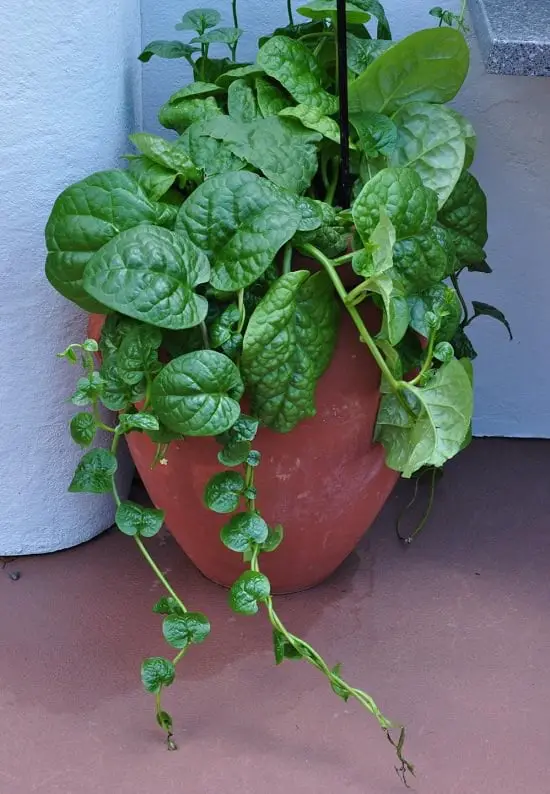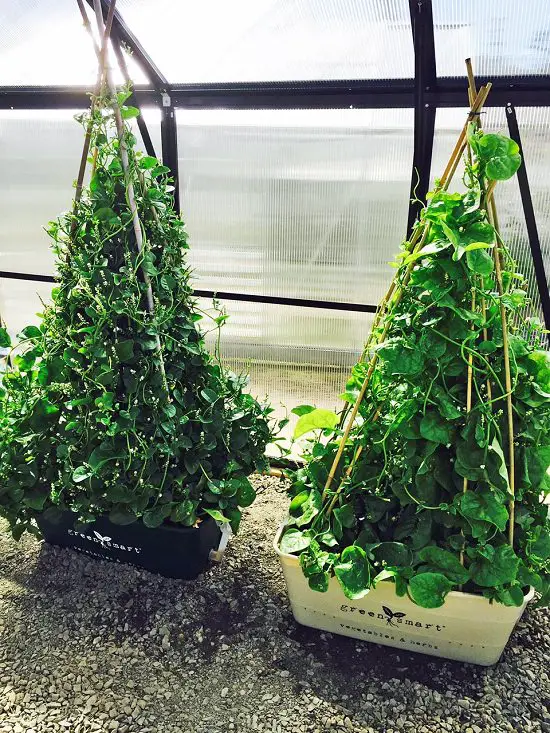Learn Growing Malabar Spinach in Pots if you’re looking for a vegetable that grows in the shade. Also, it has a rich, creamy taste like spinach!
Don’t be confused with the spinach name attached to it; the Malabar Spinach doesn’t resemble one! It is native to the Malabar region of India and a member of the Basellaceae family. So if you are wondering what exactly it is, then read on to find more and everything about Growing Malabar Spinach in Pots!
Botanical Name: Basella alba
USDA Zone: 7-11
Common Names: Ceylon Spinach, Climbing Spinach, Gui, Acelga Trapadora, Bratana, Libato, Vine Spinach, Malabar Nightshade
Check out our article on growing spinach in pots here!
What is Malabar Spinach?

When cooked, it tastes somewhat like Spinach, it is a fast-growing vine with edible leaves that emit mild spinach-like smell when crushed. Malabar spinach can be of two types, pale green and red-stemmed. The vine needs strong support and plenty of room to grow. You can grow this vegetable from seeds on the ground or in pots with support of a trellis, you can also direct it up against the wall when growing in a balcony.
Malabar Spinach Propagation
The best time to plant Malabar spinach outdoors is in Spring when the weather warms up, and all dangers of frost have passed. If you are growing it indoors, sow the seeds 6-8 weeks before the last predicted frost in your locality. In warm climates with mild winters, you can grow it any time of the year.
From Seeds
- Sow the seeds 1/4” deep.
- Seeds from Malabar Spinach usually germinate between 10 to 20 days.
- Plants will germinate faster in warm weather.
- Thin the weak seedlings and transplant the stronger ones in desired pots when you identify true leaves.
Pro Tip: If you want faster germination, soak the seeds in water overnight before planting.
From Cuttings
Propagating Malabar spinach is easiest from cuttings:
- Take 5-6 inches long cutting from a plant, just below the node.
- Plant it directly where you want to grow, in well-draining soil.
- The roots will emerge in about 2 weeks and your new plant will start to grow.
Growing Malabar Spinach in Pots

Position
It’s one of the few vegetables that grow well in shade. In a hot climate, you can even grow it in indirect sunlight. However, 4-5 hours of direct sunlight is ideal for good growth.
In a cold climate, position your container in a spot that receives part sun to full sun. Pick up the warmest spot in your garden, patio, or balcony.
Soil
Malabar spinach needs well-draining soil with neutral pH. Also, adding 20 percent aged manure or compost in your prepared soil improves the texture and richness of the growing medium.
Add 2 part sterilized garden soil, 1 part compost, 1 part peat moss or coco peat for a homemade potting mix.
Fertilizer
If you’ve added compost to enrich your soil, there is no need for supplemental feeding. If you didn’t, apply balanced liquid fertilizer once in 4-8 weeks in a weak dose.
Watering
Water the plant frequently and regularly to keep the soil moist. It requires evenly moist medium and heat to keep growing.
Support
As it is a vigorous climber, you have to provide vertical support. A trellis or twine attached to the tip of the plant and going up can make the plant climb easily. Keep in mind, the average length of the vine is around 10-15 feet in length.
Flowers and Seeds
The flowers are followed by deep-purple berries, the juice of which is used as a dye and food coloring in Asian countries. So be careful about the flooring as the berries can cause a stain when they drop.
Malabar Spinach Plant Care Tips

This plant is particularly sensitive to environmental changes and offers a variety of challenges to grow that need your attention. So follow these Malabar Spinach Plant Care points to ensure a good harvest.
- Choose a pot that is 12-16 inches in depth.
- In fall, you can gather dead plants and compost them to limit reseeding.
- Provide enough compost and aged manure to give the plant the nutrition it needs.
- Use liquid fertilizer to boost plant growth when you see a lack of growth.
- Clip the buds before they flower as they affect the taste of leaves.
Problems in Growth
Malabar spinach is a resilient plant that can grow well in the summer heat. In warmer climates, this spinach has the potential to come back the following year again. However, for colder climates, it might face a growth slowdown and start flowering with burgundy buds.
Frost Tolerance
Malabar Spinach is a tropical plant, which means that it doesn’t tolerate frost or cold, its growing period ends when cold weather arrives. If you live in an area without frost, the plant can become a perennial, growing back every year.
Here is a list of tropical plants that you can grow in winters!
Pruning
To prune Malabar spinach, you need to cut the thick, fleshy leaves while retaining some stems. Pick the buds, which flower lately so they do not affect the flavor of the leaves. Minimize flowering by keeping the soil moist enough throughout the growth period.
Check out our article on how to prune herbs here!
Pest Management
Potential pest problems include leafminers, tarnished plant bugs, and nematodes. Scout and monitor the populations to ensure proper insect control steps are taken. Check out our organic ways to get rid of pests here.
Harvesting Malabar Spinach
- Clip the leaves as per your kitchen needs.
- Harvest continuously for best yields.
- You can also harvest the fully ripened seeds to replant.
- Young stems and leaves have the most desired flavor.
- The leaves taste best when they’re fresh so they should be used quickly after harvest.
Malabar Spinach Nutrition
Malabar Spinach is high in nutrition with 19kcal calories, 3.4g Carbohydrates, a meager amount of fat (0.3g), and is very high in Protein-1.8g per 100gms of serving!
It is also very rich in vitamins like Vitamin A, Thiamine, Riboflavin, Niacin, Vitamin B6, and Vitamin C. It has a high mineral composition with Calcium, Iron, Magnesium, Phosphorus, Potassium, and Zinc.
Why Grow Malabar Spinach?
Malabar Spinach can be used in a variety of dishes like coconut-based curries and in a vegetable dish called Utan that can be served with rice. It also pairs well with seafood like prawns, clams, dried fish, and horse gram that can be prepared with a gravy called Gassi, which is eaten with rice dumplings called Pundi. It is also popular as the main ingredient in fritters/pakora in India.



Very Nice information
I have 12 in pots that are about 10 to 12 inches deep. How many seeds did you plant in your pot? I see a lot on other sites to thin them to every 12″ apart. But I know rules change for potted plants.